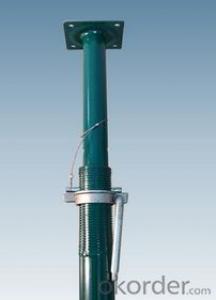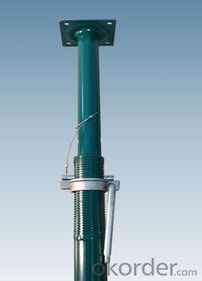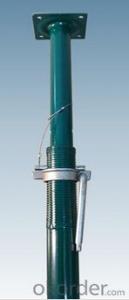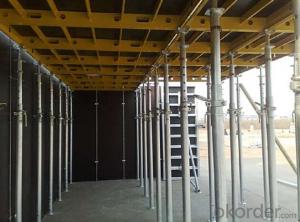scaffording shoring acrow steel -prop system
- Loading Port:
- Tianjin
- Payment Terms:
- TT OR LC
- Min Order Qty:
- 10000 PCS
- Supply Capability:
- 10000 PCS/month
OKorder Service Pledge
OKorder Financial Service
You Might Also Like
Quick Details
Packaging & Delivery
| Packaging Detail: | Pallets with steel belt |
| Delivery Detail: | within 3 weeks |
Specifications
1. shoring prop meteril :Q235
2. surface finished:painted/HDP
3. type:light medium heavy duty prop
4.colour :red yellow blue
Adjustable length(M) | Tube Size | Weight(Kg) |
1.4—2.5m | Out tube 60*3.2mm Inner tube 48*2.8mm | 13.1 |
1.6—2.7m | 14.5 | |
2.0—3.5m | 16.1 | |
2.2—4m | 19.27 | |
3—5.5m | 27.36 |
WHY YOU CHOOSE US:
1. We have many years of experiences.
2. We have many certificates which can assure the quality of our products.
3. We have many projects in the shipyard companies of south of China.
4. We have strong engineering team that can give best solution for your projects.
5. We can take you to visit our factory.
6.Good after-sale service offered,please get back if you have any question.
Our Service:
1.Your inquiry related to our product & price will be replied within 24hours.
2.Well-trained &experienced staff are to answer all your inquiries professional in English of
course.
3.Working time: 8:00am - 5:30pm, Monday to Friday. OEM is highly welcomed.
4.We have strong R&D team here to help.
5.Your business relationship with us will be confidential to any third party.
6. Good after-sale service offered, please get back if you got question.
- Q: How do you prevent steel props from slipping on smooth surfaces?
- To prevent steel props from slipping on smooth surfaces, there are several measures you can take: 1. Use anti-slip pads or mats: Place anti-slip pads or mats underneath the steel props to create friction between the surface and the props. These pads are usually made of rubber or other materials with high grip properties, which help to prevent slipping. 2. Apply adhesive tapes: Another effective method is to use adhesive tapes on the base of the steel props. These tapes, such as grip tapes or non-skid tapes, have a rough surface that enhances friction and prevents the props from sliding on smooth surfaces. 3. Utilize weight distribution: Ensure that the weight load on the steel props is evenly distributed across the surface area. This can be achieved by placing additional weights on top of the props or adjusting the load distribution if possible. By doing so, the downward pressure increases, increasing friction and reducing the chance of slipping. 4. Secure props with clamps or brackets: Use clamps or brackets to firmly secure the steel props to the surface. This will minimize any movement or shifting that could lead to slipping. 5. Consider using floor anchors: In some cases, it may be necessary to install floor anchors for more stability. These anchors can be drilled into the surface, providing a secure attachment point for the steel props and reducing the risk of slipping. 6. Choose props with anti-slip features: When selecting steel props, look for models that have built-in anti-slip features. Some props come with specially designed rubber or non-slip coatings on the base that provide better grip on smooth surfaces. It is important to assess the specific requirements and conditions of the project to determine the most suitable method for preventing steel props from slipping on smooth surfaces.
- Q: Are steel props suitable for use in the construction of theaters?
- Yes, steel props are commonly used in the construction of theaters due to their durability, strength, and stability. They provide necessary support for stage sets, backdrops, and lighting equipment, ensuring the safety and structural integrity of the theater.
- Q: Can steel props be used in supporting temporary lighting systems?
- Indeed, temporary lighting systems can rely on steel props for support. These adjustable and telescopic support systems, known as steel props, are frequently utilized in construction to uphold temporary structures and loads. Possessing robustness and stability, they prove ideal for sustaining temporary lighting systems. Steel props effortlessly adapt to desired heights and endure the weight of lighting fixtures and cables. Moreover, their durability guarantees resilience against outdoor conditions, offering a trustworthy support system for temporary lighting.
- Q: How do steel props contribute to the prevention of wall and floor cracks?
- Steel props, also known as adjustable steel props or acrow props, play a vital role in preventing wall and floor cracks. These props are used in construction and renovation projects to support and stabilize walls, floors, and other structural elements. One way steel props contribute to the prevention of wall and floor cracks is by providing temporary support to load-bearing walls or beams during construction or renovation. This helps to distribute the weight evenly and reduce the risk of excessive stress on the walls or floors, which could lead to cracks or structural damage. Moreover, steel props can be adjusted to the required height, allowing for precise and controlled support. This is particularly important when dealing with uneven or sloping floors, as it helps to maintain the level and stability of the structure. By ensuring a level and stable base, steel props help to prevent any unnecessary movement or shifting that could result in cracks in the walls or floors. Additionally, steel props provide lateral support, which helps to prevent any lateral movement or displacement of walls or floors. This is especially crucial in areas prone to seismic activity or high winds, as it helps to minimize the risk of cracks caused by lateral forces. Furthermore, steel props are made of high-quality steel, which provides excellent strength and durability. This means they can withstand heavy loads and pressures, ensuring the structural integrity of the walls and floors. By providing reliable and robust support, steel props help to prevent any excessive bending or deformation that could lead to cracks in the walls or floors. In summary, steel props contribute to the prevention of wall and floor cracks by providing temporary support, maintaining a level and stable base, offering lateral support, and ensuring the structural integrity of the walls and floors. Their adjustable nature and strength make them an invaluable tool in construction and renovation projects, helping to maintain the overall stability and longevity of the structure.
- Q: Can steel props be used for temporary or permanent support?
- Depending on the specific needs of a project, steel props have the capability to be used for both temporary and permanent support. When it comes to construction and civil engineering projects, steel props are commonly employed to provide temporary support during the process of construction or renovation. Adjustable in height, they have the ability to support various loads and structures, allowing for flexibility. In temporary situations, steel props are typically utilized to support formwork, scaffolding, or shoring systems. They offer a reliable and safe solution to ensure stability and prevent collapse during construction, ultimately safeguarding the structures. Once the construction work is finished, the steel props can be effortlessly removed and repurposed for future projects. Nevertheless, there are instances where steel props can be employed for permanent support. In situations where a structure requires ongoing support or reinforcement, permanent installation of steel props becomes necessary. This may be the case for buildings with weak foundations, structures that have undergone structural modifications, or structures at risk of settlement or subsidence. Permanent steel props are generally installed with careful engineering, taking into account factors such as load-bearing capacity, structural integrity, and long-term stability. They may be designed as part of a comprehensive structural support system, combining different elements like steel beams, columns, and braces, which contribute to the overall stability of the structure. It is important to emphasize that the decision to use steel props for temporary or permanent support relies on various factors, including project-specific requirements, load-bearing calculations, and consideration of structural engineering. Consulting with a professional engineer or structural expert is essential in order to determine the most suitable solution for each situation.
- Q: Are steel props adjustable on sloping surfaces?
- Yes, steel props are adjustable on sloping surfaces. Steel props, also known as adjustable steel props or steel jacks, are designed with a threaded screw mechanism that allows for height adjustment. This feature enables them to be used on various surfaces, including sloping surfaces. By simply turning the threaded screw, the length of the prop can be increased or decreased, allowing it to adapt to different inclinations. This adjustability feature makes steel props versatile and suitable for a wide range of construction and support applications, regardless of the surface gradient.
- Q: What are the advantages of using steel props compared to other support systems?
- Compared to other support systems, steel props offer several advantages. To begin with, steel props are renowned for their ability to bear heavy loads. They can withstand substantial weight and provide sturdy support to structures, making them suitable for a wide range of construction projects, including large-scale buildings and infrastructure. Additionally, steel props are adjustable, providing easy customization and flexibility. The prop's length can be effortlessly extended or shortened to meet the specific requirements of the project. This adaptability makes them highly versatile and suitable for different construction scenarios. Furthermore, steel props are durable and long-lasting. They are crafted from high-quality steel materials known for their strength and resistance to wear and tear. This ensures that the props can endure the demanding conditions of the construction site and remain in excellent condition for an extended period. Moreover, steel props are relatively lightweight, making them easier to handle and transport compared to other support systems. This not only boosts efficiency on the construction site but also reduces labor costs associated with prop installation and removal. Furthermore, steel props are cost-effective. They provide a cost-efficient solution for temporary support needs, as they can be rented or purchased at a reasonable price. Additionally, their reusability further enhances their economic advantage, as they can be utilized multiple times across different projects. Additionally, steel props enhance safety on construction sites. Their robust construction and high load-bearing capacity minimize the risk of structural failure or collapse, ensuring the safety of workers and the integrity of the project. In conclusion, steel props offer numerous advantages over other support systems, including high load-bearing capacity, adjustability, durability, lightweight nature, cost-effectiveness, and enhanced safety. These benefits have made steel props a popular choice in the construction industry for various temporary support needs.
- Q: Embedded dislocation, steel support how to put? Metro Shield Construction
- Estimates also corrected the past, relatively short, only to change the location of the bolt hole.
- Q: Are steel props suitable for supporting temporary canopies or awnings?
- Yes, steel props are suitable for supporting temporary canopies or awnings. Steel props are known for their strength, stability, and durability, making them an excellent choice for providing support to temporary structures like canopies or awnings. They can withstand heavy loads and adverse weather conditions, ensuring the stability and safety of the temporary structure.
- Q: Can steel props be used in mining projects?
- Steel props are indeed applicable in mining projects. They go by the names of temporary supports or temporary roof supports, and their purpose is to offer temporary structural reinforcement to the roof and walls of mine tunnels or shafts. Constructed from durable, high-strength steel, these props are engineered to endure the immense weight and pressure exerted by the surrounding rock and soil. Their adjustable length feature facilitates effortless installation and removal throughout the course of mining operations. The indispensability of steel props lies in their ability to avert roof collapses and maintain the stability of underground workings, making them a crucial element in ensuring mine safety.
Send your message to us
scaffording shoring acrow steel -prop system
- Loading Port:
- Tianjin
- Payment Terms:
- TT OR LC
- Min Order Qty:
- 10000 PCS
- Supply Capability:
- 10000 PCS/month
OKorder Service Pledge
OKorder Financial Service
Similar products
Hot products
Hot Searches
Related keywords























